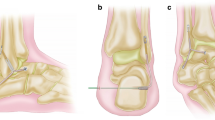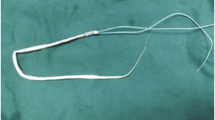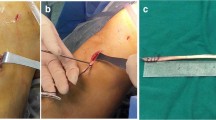Abstract
Purpose
Subtalar instability (STI) has often been obscured by lateral ankle instability. Moreover, although there have been several reports of techniques for reconstructing STI, no clinical outcome results are known to have been published. The authors report the clinical and radiographic outcomes of the ligament reconstruction of STI with a recently reported novel technique utilising a semitendinosus tendon allograft and interference screws.
Methods
This study is based on 20 ankles that underwent ligament reconstruction for STI between 2009 and 2013. The average follow-up period was 15.0 ± 5 months, and the average age at surgery was 28.1 ± 10.8 years old. Visual analogue (VAS) pain scores, American Orthopedic Foot and Ankle Society (AOFAS) and Karlsson–Peterson ankle scores as well as patient satisfaction were evaluated. Radiographic evaluation of medial translations of calcaneus and subtalar tilt angles was preformed with ankle and Broden’s stress radiographs.
Results
The VAS pain score decreased from 6.1 ± 1.1 preoperatively to 1.8 ± 1.2 post-operatively (p < 0.05). The AOFAS score improved from 66.0 ± 12.2 preoperatively to 89.6 ± 6.7 post-operatively, and the Karlsson–Peterson score improved from 57.0 ± 13.5 to 91.1 ± 6.8 (p < 0.05). There were no complications such as recurred STI or subtalar joint stiffness. All of the patients were satisfied with the surgery. Subtalar tilt angle decreased from 11.5° preoperatively to 3.0° post-operatively, and the calcaneal medial translations decreased from 7.4 to 3.9 mm.
Conclusion
This is the first report on the comprehensive clinical and radiographic outcomes of STI reconstruction using a semitendinosus tendon allograft and interference screws. The novel technique of STI reconstruction was found to show encouraging clinical outcomes with high patient satisfaction.
Levels of evidence
IV.




Similar content being viewed by others
References
Bonnel F, Toullec E, Mabit C, Tourne Y (2010) Chronic ankle instability: biomechanics and pathomechanics of ligaments injury and associated lesions. Orthop Traumatol Surg Res 96(4):424–432
Broden B (1949) Roentgen examination of the subtaloid joint in fractures of the calcaneus. Acta Radiol 31(1):85–91
Choisne J, Ringleb SI, Samaan MA, Bawab SY, Naik D, Anderson CD (2012) Influence of kinematic analysis methods on detecting ankle and subtalar joint instability. J Biomech 45(1):46–52
Chrisman OD, Snook GA (1969) Reconstruction of lateral ligament tears of the ankle. An experimental study and clinical evaluation of seven patients treated by a new modification of the Elmslie procedure. J Bone Joint Surg Am 51(5):904–912
Clanton TO, Betech AA, Bott AM, Matheny LM, Hartline B, Hanson TW, McGarvey WC (2013) Complications after tendon transfers in the foot and ankle using bioabsorbable screws. Foot Ankle Int 34(4):486–490
Coughlin MJ, Schenck RC Jr, Grebing BR, Treme G (2004) Comprehensive reconstruction of the lateral ankle for chronic instability using a free gracilis graft. Foot Ankle Int 25(4):231–241
de Asla RJ, Wan L, Rubash HE, Li G (2006) Six DOF in vivo kinematics of the ankle joint complex: application of a combined dual-orthogonal fluoroscopic and magnetic resonance imaging technique. J Orthop Res 24(5):1019–1027
Heilman AE, Braly WG, Bishop JO, Noble PC, Tullos HS (1990) An anatomic study of subtalar instability. Foot Ankle 10(4):224–228
Hennrikus WL, Mapes RC, Lyons PM, Lapoint JM (1996) Outcomes of the Chrisman-Snook and modified-Brostrom procedures for chronic lateral ankle instability. A prospective, randomized comparison. Am J Sports Med 24(4):400–404
Coughlin MJ, Saltzman CL, Anderson RB (eds) (2014) Athletic injuries to the soft tissue of the foot and ankle. In: Mann’s surgery of the foot and ankle, vol 2, 9th edn. Elsevier Saunders, Philadelphia, pp 1558–1559
Jung HG, Kim TH (2012) Subtalar instability reconstruction with an allograft: technical note. Foot Ankle Int 33(8):682–685
Kamada K, Watanabe S, Yamamoto H (2002) Chronic subtalar instability due to insufficiency of the calcaneofibular ligament: a case report. Foot Ankle Int 23(12):1135–1137
Karlsson J, Bergsten T, Lansinger O, Peterson L (1988) Lateral instability of the ankle treated by the Evans procedure. A long-term clinical and radiological follow-up. J Bone Joint Surg Br 70(3):476–480
Karlsson J, Eriksson BI, Renstrom PA (1997) Subtalar ankle instability. A review. Sports Med 24(5):337–346
Kato T (1995) The diagnosis and treatment of instability of the subtalar joint. J Bone Joint Surg Br 77(3):400–406
Keefe DT, Haddad SL (2002) Subtalar instability. Etiology, diagnosis, and management. Foot Ankle Clin 7(3):577–609
Kjaersgaard-Andersen P, Wethelund JO, Nielsen S (1987) Lateral talocalcaneal instability following section of the calcaneofibular ligament: a kinesiologic study. Foot Ankle 7(6):355–361
Larsen E (1988) Tendon transfer for lateral ankle and subtalar joint instability. Acta Orthop Scand 59(2):168–172
Leonard MH (1949) Injuries of the lateral ligaments of the ankle; a clinical and experimental study. J Bone Joint Surg Am 31A(2):373–377
Lui TH (2007) Arthroscopic-assisted lateral ligamentous reconstruction in combined ankle and subtalar instability. Arthroscopy 23(5):e1-554
Martin LP, Wayne JS, Owen JR, Smith RT, Martin SN, Adelaar RS (2002) Elongation behavior of calcaneofibular and cervical ligaments in a closed kinetic chain: pathomechanics of lateral hindfoot instability. Foot Ankle Int 23(6):515–520
Michelson J, Hamel A, Buczek F, Sharkey N (2004) The effect of ankle injury on subtalar motion. Foot Ankle Int 25(9):639–646
Milgrom C, Giladi M, Simkin A, Stein M, Kashtan H, Margulies J, Steinberg R, Aharonson Z (1985) The normal range of subtalar inversion and eversion in young males as measured by three different techniques. Foot Ankle 6(3):143–145
Paterson R, Cohen B, Taylor D, Bourne A, Black J (2000) Reconstruction of the lateral ligaments of the ankle using semi-tendinosis graft. Foot Ankle Int 21(5):413–419
Pisani G (1996) Chronic laxity of the subtalar joint. Orthopedics 19(5):431–437
Sabonghy EP, Wood RM, Ambrose CG, McGarvey WC, Clanton TO (2003) Tendon transfer fixation: comparing a tendon to tendon technique vs. bioabsorbable interference-fit screw fixation. Foot Ankle Int 24(3):260–262
Sammarco GJ, Idusuyi OB (1999) Reconstruction of the lateral ankle ligaments using a split peroneus brevis tendon graft. Foot Ankle Int 20(2):97–103
Schon LC, Clanton TO, Baxter DE (1991) Reconstruction for subtalar instability: a review. Foot Ankle 11(5):319–325
Snook GA, Chrisman OD, Wilson TC (1985) Long-term results of the Chrisman-Snook operation for reconstruction of the lateral ligaments of the ankle. J Bone Joint Surg Am 67(1):1–7
Tourné Y, Besse L, Mabit C, Sofcot (2010) Chronic ankle instability. Which tests to assess the lesions? Which therapeutic options? Orthop Traumatol Surg Res 96(4):433–446
Tourné Y, Mabit C, Moroney P, Chaussard C, Saragalia D (2012) Long-term follow-up of lateral reconstruction with extensor retinaculum flap for chronic ankle instability. Foot Ankle Int 33(12):1079–1086
Yamamoto H, Yagishita K, Ogiuchi T, Sakai H, Shinomiya K, Muneta T (1998) Subtalar instability following lateral ligament injuries of the ankle. Injury 29(4):265–268
Acknowledgments
This work was supported by Konkuk University.
Conflict of interest
The authors declare that they have no conflict of interest.
Author information
Authors and Affiliations
Corresponding author
Rights and permissions
About this article
Cite this article
Jung, HG., Park, JT., Shin, MH. et al. Outcome of subtalar instability reconstruction using the semitendinosus allograft tendon and biotenodesis screws. Knee Surg Sports Traumatol Arthrosc 23, 2376–2383 (2015). https://doi.org/10.1007/s00167-015-3504-0
Received:
Accepted:
Published:
Issue Date:
DOI: https://doi.org/10.1007/s00167-015-3504-0




